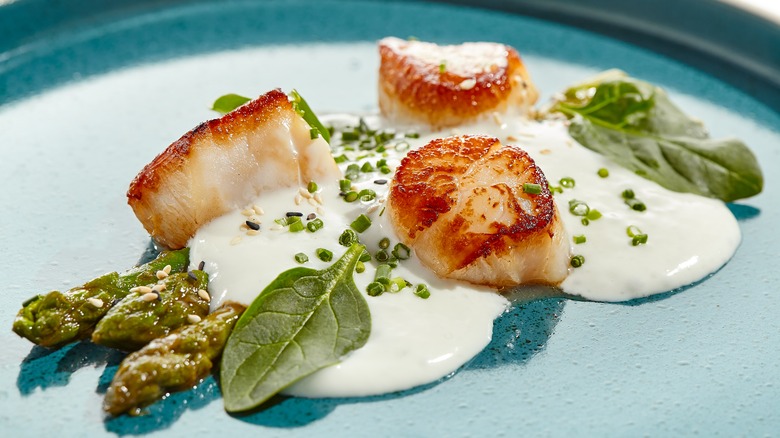Why You Should Only Buy Female Scallops Whenever Possible
If you've ever eaten those tender little pats of sea butter otherwise known as the bivalve mollusk we call scallops, then you're probably a fan. Simple, delicate, and tender, scallops are just as good fresh with grapefruit in ceviche as they are seared to a caramelly crust with a blood orange gastrique. Given that these are such accommodating little creatures, there are countless scallop recipes to try, but first let's explore some advice on how to buy them. Look for sea scallops (the ones much larger than bay scallops) that are peach-pink; that means they're females and will taste more rich and sweet than their white counterparts.
Think of them as blushing scallops, and forget the idea that this coloration is an abnormality. It's due to an abundance of zeaxanthin, a natural pigment associated with spawning. When the female sea scallops fill with coral-red roe, some of that pigment also colors the neighboring adductor muscle — which is not only what the scallop uses to open and close its shell, but the thing we eat. If a female is harvested during spawning (usually in late summer to early fall for the Atlantic variety; occasionally in early spring), she's going to show up in your local fishmonger with that characteristic pinky hue. Bay scallops, meanwhile, are hermaphroditic, so their color and flavor will be less pronounced during spawning.
Carrots, saffron, and sea scallop roe
Zeaxanthin is a naturally-occurring carotenoid molecule which, like other carotenoids, gives corn, saffron, egg yolks, carrots, and spawning sea scallop roe their colors. Zeaxanthin is not only found in our eyes (more specifically the center of the retina), it's also a powerful antioxidant essential to good vision health. You might remember that old saw about how carrots are good for your vision — it's actually true. According to Healthline, zeaxanthin can help reduce the risk of eye-related issues like cataracts, glaucoma, and macular degeneration. That's all cool, but how would it affect the flavor of the sea scallop as well as its color?
Zeaxanthin breaks down to form safranal, the organic compound associated with the delicate flavor and glorious aroma of saffron (and thus saffron tea) and itself a potent antioxidant. So, if you have to make a decision between buying peach-colored sea scallops tinted with a pigment that not only tastes great but is good for your eye health or the boring, plain-white guys, it would seem like your choice has already been made. But there are other scallop-buying criteria you should know.
Additional scallop-buying considerations
So, you already know to look for lovely pink spawning female sea scallops at the fishmongers — but there are other tips to maximize your scallop experience. The savvy home cook knows to buy seafood that is not only high in quality but harvested in a way that is eco-friendly. In the United States, this means buying sea scallops that have either been ethically farmed or sustainably caught. (Most sea scallops are farmed.) If you're buying scallops that have been previously frozen, look for things like discoloration (beyond the good version previously discussed), ice crystals, and freezer burn.
If you're buying pre-packaged scallops, avoid the so-called wet-packed versions, because not only do they contain seawater (no big deal), but they will also have been treated with artificial preservatives. Not only does this method increase the scallops' weight and shelf life, it will cause them to release more water when being cooked — something that's fine for steaming, but actively works against searing. Choose dry-packed scallops instead. Because sea scallops are so large, they're usually the featured protein in fairly uncomplicated dishes like simple seared scallops — so be advised.


